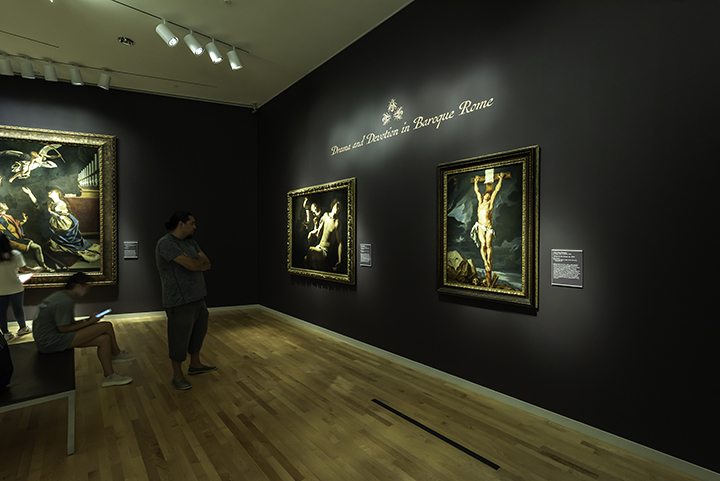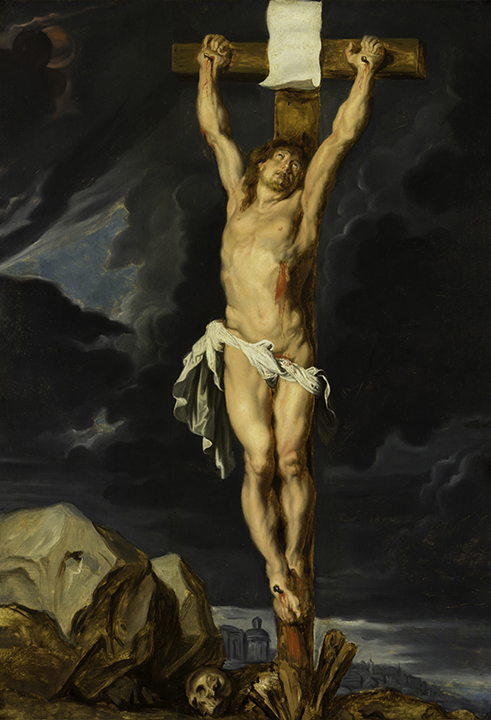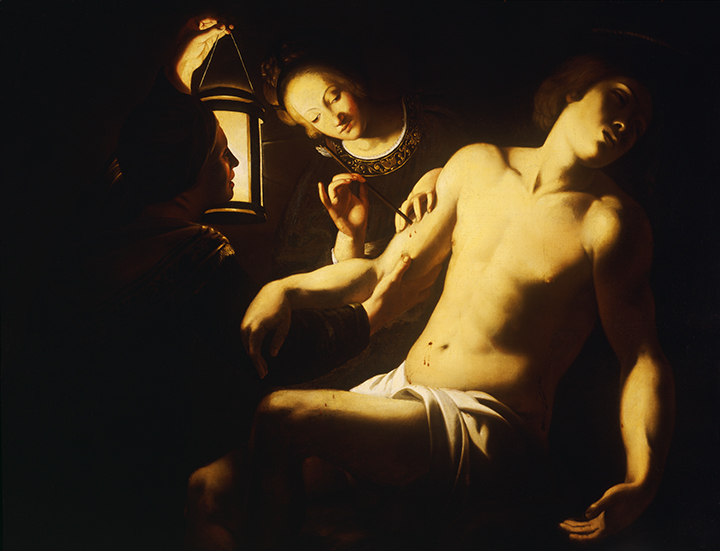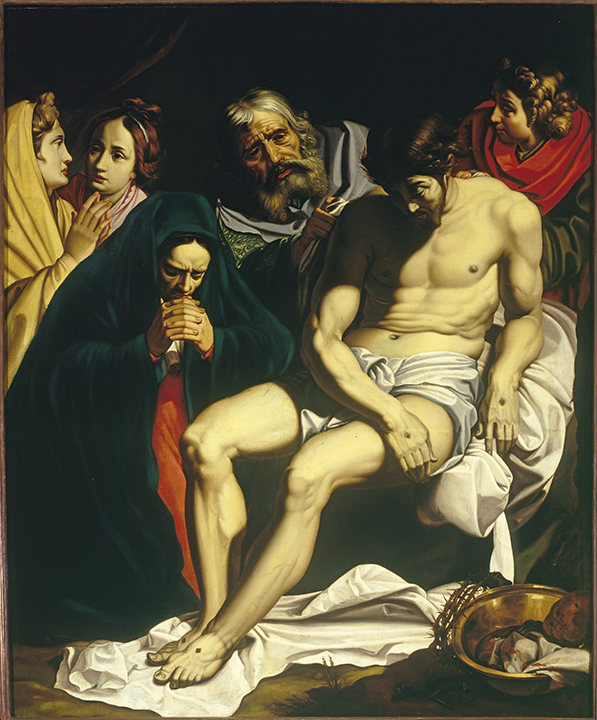
Drama and Devotion in Baroque Rome
Many schools of painting converged in Rome, but artists were particularly receptive to the stylistic revolution of Michelangelo Merisi da Caravaggio (1571 – 1610). Caravaggio only worked for about 15 years and produced roughly 70 paintings, with few examples in American collections. Nonetheless, he remains one of the most influential figures in Western art. The works in this exhibition, all from the Museum and Gallery at Bob Jones University, celebrate how he shaped the Italian Baroque and galvanized numerous followers.
Caravaggio settled in the capital around 1595. At the time, Pope Clement VIII (1592 – 1605) was promoting the building of new churches and the renovation of old ones as symbols of a flourishing Catholic faith. Nearly 2,000 artists competed to fulfill this ambitious program. Caravaggio’s trademark style involved stark contrast of light and dark, vigorous modeling, bare background, unsettling realism, use of live models and a dramatic sense of staging. His religious paintings emphasized the emotional state of the figures and inspired introspection. His secular compositions of musicians, cardsharps and fortune tellers are more theatrical and playful.

Peter Paul Rubens
(b. Siegen, 1577; d. Antwerp, 1640)
“Christ on the Cross,” ca. 1610
Oil on panel
Museum and Gallery at Bob Jones University, Greenville, SC
Rubens was in Italy from 1600 to 1608. Whether he was in contact with Caravaggio is unknown, but he did have the opportunity to study the Italian master’s work. He led a campaign to acquire Caravaggio’s Madonna of the Rosary for the church of Saint Paul in Antwerp. Rubens made this painting after returning to Flanders, but it betrays his Italian experience. The stark light hitting Christ’s body, the brilliant white of the loincloth, and the elongated suffering body all convey the drama of Jesus’s humanity and sacrifice. This panel was likely a modello for Rubens’ apprentices to study and copy.

Trophime Bigot
(b. Arles, 1579; d. Avignon, 1650)
“Saint Sebastian Tended by Saint Irene,” n.d.
Oil on canvas
Museum and Gallery at Bob Jones University, Greenville, SC
Bigot was in Rome in the 1620s and left by 1634. He often depicted the same subject matter, and this painting is one of four versions. Caravaggio’s impact is visible in the tight framing of the action and the presentation of isolated figures performing a specific task. Saint Irene tenderly removes the arrows from the body of Saint Sebastian, whose posture recalls Christ’s descent from the cross. Dramatic light allows the viewer to see faint drops of blood. Saint Sebastian, invoked in the Middle Ages against the plague, was one of the most painted saints until the 17th century.

Orazio Gentileschi (or studio)
(b. Pisa, 1563; d. London, 1639)
“The Martyrs Saint Valeriano, Saint Tiburzio and Saint Cecilia,” ca. 1620 – 21
Oil on canvas
Museum and Gallery at Bob Jones University, Greenville, SC
Orazio Gentileschi moved to Rome as a teenager. He became friends with Caravaggio around 1600, but their relationship was tested when the painter Giovanni Baglione sued them for libel. Gentileschi’s works express careful observation of Caravaggio’s compositions and a predilection for the same themes. In this episode from the life of Saint Cecilia, Valeriano converts to Christianity upon seeing an angel hand his wife a floral wreath of purity. Tiburzio, Valeriano’s brother, witnesses the event from the doorway and is also moved to convert. Intense colors and luxurious fabrics highlight Gentileschi’s articulation of detail. Sharp diagonals guide the viewer’s gaze across the canvas.

Giovanni Lanfranco
(b. Parma, 1582; d. Rome, 1647)
“Saint Cecilia,” ca. 1620 – 21
Oil on canvas
Museum and Gallery at Bob Jones University, Greenville, SC
Giovanni Lanfranco arrived in Rome at the beginning of the 1600s. He succeeded as a fresco painter but left the competitive art scene of the capital for Naples, where he worked for more than a decade. This image of the patron saint of music emphasizes the splendor of the Catholic faith and the supremacy of the church. Gazing up to the heavens, Cecilia conveys her divine inspiration while she plays.

Abraham Janssens
(Antwerp, ca. 1575–1632)
“Lamentation over the Dead Christ,” ca. 1610 – 12
Oil on canvas
Museum and Gallery at Bob Jones University, Greenville, SC
Abraham Janssens was one of many Flemish artists who traveled to Rome in the late 1590s. Upon his return to Flanders in 1602, he achieved considerable success as a history painter. He continued to promote Caravaggio’s manner before adopting the more fashionable Rubenesque style. Paintings of this scene typically include the Virgin Mary (at left), weeping over her dead son. Exaggerated faces convey a somber mood. The discarded crown of thorns, nails from the Cross, and Veil of Veronica signify the coming resurrection.

Simon Vouet
(Paris, 1590–1649)
“Salome with the Head of Saint John the Baptist,” 1614 – 27
Oil on canvas
Museum and Gallery at Bob Jones University, Greenville, SC
Simon Vouet was in Rome by 1613, where he studied Caravaggio’s works and painted the same themes. This painting tells the story of John the Baptist, who was imprisoned for speaking out against King Herod’s divorce and remarriage. Pleased and drunk, Herod promised to give his new wife’s daughter, Salome, anything she desired. Persuaded by her mother, she asked for the saint’s head on a platter. Salome’s elegance and calm presence contradict the gruesome nature of her request and the dauntingly realistic rendering of the saint’s head.
Click and drag in the photo below to see a 360° view of the installed exhibition.
[wpvr id=”5180″]